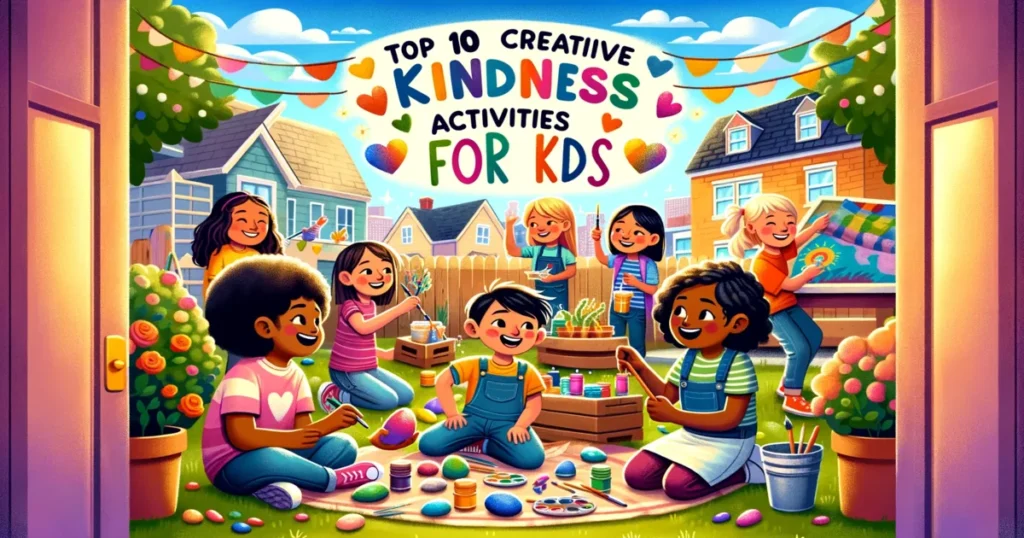Introduction How to Tell your Kids about Santa:
Wondering how to tell your kids about Santa? This guide is just what you need. We’ll take you through easy, loving ways to introduce Santa to your little ones, keeping the magic of the season alive. Whether you’re starting the Santa story for the first time or navigating the tricky questions from a curious older child, we’ve got you covered.

This article ‘How to Tell your Kids about Santa’ is packed with simple, expert tips to help you share the story of Santa in a way that’s fun, magical, and just right for your family. So, let’s dive into creating those special holiday moments that your children will cherish for years to come.
Understanding the Magic of Santa:
Telling your kids about Santa is more than just sharing a holiday character; it’s about introducing them to a world of imagination and wonder. The story of Santa Claus can inspire a sense of excitement and mystery in your children, sparking their creativity and joy during the holiday season. It’s a special part of childhood that combines the fun of surprises with the warmth of family traditions.
Tip: Share stories about Santa that emphasize kindness, generosity, and the joy of giving, rather than focusing solely on receiving gifts.
Balancing Fantasy and Reality:
As parents, it’s important to strike a delicate balance when you explain Santa to your kids. You want to nurture their sense of wonder and fantasy, while also gently preparing them to understand the line between make-believe and reality as they grow. This balance helps children enjoy the magic of Santa while slowly developing their ability to discern fiction from truth.
Tip: Use storytelling to convey the essence of Santa. Let your child’s questions guide how much detail you go into about the reality of Santa.
Age-Appropriate Explanations:
The way you discuss Santa should evolve with your child’s age. Younger children are more likely to embrace the magical aspect of Santa wholeheartedly, while older children might start to question his existence. It’s important to respect their developing minds and provide explanations that match their level of understanding and curiosity.
Tip: For younger kids, keep the story simple and magical. For older children, gently lead them to understand the symbolic meaning of Santa.
Handling Doubts and Questions:
As children grow, they naturally begin to question the world around them, and Santa is no exception. And they want to know about Santa and Parents need How to Tell your Kids about Santa. It’s essential to listen to their questions and address their doubts in a way that respects their developing critical thinking skills. This can be a valuable opportunity to encourage their inquisitiveness and honesty.
Tip: If they start questioning, ask what they think and feel. This opens a conversation that respects their developing critical thinking.
Incorporating Santa into Family Traditions:
Santa can be a wonderful addition to your family’s holiday traditions, adding an extra layer of excitement and anticipation to the festivities. Whether it’s through special activities like baking cookies for Santa or tracking his sleigh online, incorporating Santa into your family traditions can create joyful memories and strengthen family bonds.
Tip: Create traditions like leaving out cookies for Santa or writing letters to him. These activities build up the festive spirit and the joy of believing.
Teaching the Spirit of Giving:
The story of Santa is an excellent way to teach children about the spirit of giving and selflessness. So, it emphasizes the joy of making others happy and the importance of thinking about others. This lesson in generosity is a valuable part of the Santa tradition and can be a foundational aspect of your child’s character development.
Tip: Encourage your children to give back during the holidays, like donating toys or helping others, to emulate Santa’s giving spirit.
Respecting Diverse Beliefs:
In a world filled with diverse cultures and beliefs, it’s important to teach your children that not everyone celebrates Santa in the same way. This understanding fosters empathy and respect for other traditions and beliefs, which are essential values in today’s global society.
Tip: Explain that every family has its own way of celebrating and that it’s important to respect others’ beliefs and traditions.
Creating a Comfortable Space for Discussion:
Children should feel comfortable asking questions and expressing their thoughts about Santa and other holiday traditions. Creating an open and supportive environment for these discussions can strengthen your bond with your child and encourage honest and open communication.
Tip: Create a warm and open atmosphere where your child feels safe to share their thoughts and feelings about Santa and the holidays.
Evolving the Santa Story as They Grow:
As your children mature, their understanding and perception of Santa will naturally change. It’s important to allow the Santa story to evolve with them, adapting to their growing maturity and understanding of the world. This evolution can help them transition from believing in Santa as a person to embracing the broader themes of love, generosity, and holiday magic.
Tip: Gradually shift the focus from Santa as a person to the broader themes of love, generosity, and the magic of the holiday season.
Preserving the Joy of the Season:
Ultimately, the goal in telling your kids about Santa is to preserve the joy, excitement, and magic of the holiday season. It’s an opportunity to celebrate the warmth, love, and togetherness. That defines this special time of year, creating lasting memories and traditions that your family will treasure.
Tip: Focus on the aspects of the holiday season that bring joy and togetherness, regardless of how your family chooses to include Santa in your celebrations.

Table: Age-Appropriate Ways for How to Tell your Kids about Santa
Navigating the conversation about Santa can vary significantly as your children grow. This table is designed to offer you a quick reference for handling the Santa topic with your kids at different ages. In Addition, It provides age-appropriate strategies that align with their understanding and curiosity. Ensuring that the magic of Santa is tailored to their developmental stage. This guide helps create a seamless transition in the way Santa is introduced and discussed as your child matures.
| Age Group | How to Tell your Kids about Santa |
|---|---|
| Toddlers (1-3 years) | Focus on the magic and wonder of Santa. Keep the story simple and enchanting, like talking about Santa’s sleigh and reindeer. |
| Preschoolers (4-5 years) | Introduce Santa-related activities, such as writing letters to Santa and leaving out cookies. Encourage imaginative play around the Santa theme. |
| School-Aged (6-9 years) | Address their questions about Santa more directly, while still maintaining the magical aspect. Begin introducing concepts of Santa symbolizing the spirit of giving. |
| Tweens (10+ years) | Discuss the symbolic meaning of Santa, focusing on the values of kindness, generosity, and the joy of the holiday season. Encourage them to be part of the Santa magic for younger siblings or family members. |
This table aims to guide you through each stage of your child’s development. Making the Santa conversation a positive and memorable part of their childhood and holiday experiences.
Facts and Figures for How to Tell your Kids about Santa:
When diving into the topic of how to tell your kids about Santa, it’s fascinating to look at some facts and figures that highlight the importance of this tradition:
- Belief in Santa: Surveys have shown that about 85% of young children in the United States believe in Santa Claus, indicating the widespread cultural significance of this tradition.
- Developmental Benefits: Research suggests that engaging in the Santa story can help with children’s emotional development. Because of this, Enhancing creativity and the ability to distinguish between reality and fiction as they grow.
- Global Variations: The concept of Santa Claus, or similar figures, exists in various forms across the world, each with its own unique traditions, showing the universal appeal of a gift-giving holiday figure.
FAQs for How to Tell your Kids about Santa:
Q: How can I start the conversation about Santa with my young child?
Begin by introducing Santa as a fun and magical character of the holiday season. Use simple stories or books about Santa to spark their imagination.
Q: What should I do if my older child asks if Santa is real?
Listen to their thoughts first and then gently guide the conversation. You can explain that Santa represents the spirit of giving and joy. And everyone can be a ‘Santa’ by spreading kindness.
Q: Is it okay for my child to believe in Santa?
Yes, believing in Santa is a normal and healthy part of childhood for many. It encourages imagination and brings excitement to the holiday season.
Final words on How to Tell your Kids about Santa:
Telling your kids about Santa is a beautiful tradition that brings joy and wonder to the holiday season. It’s a chance to ignite their imagination, teach them about kindness and generosity, and create lasting family memories. Remember, every family is different, and how you introduce Santa should fit comfortably with your family values and beliefs.

Above all, the story of Santa is about capturing the magic of childhood and the warmth of the holiday season. So, embrace this special time with your kids. And enjoy creating those magical moments that they will remember for years to come.
Important Points:
- Introduce Santa as a magical character, adjusting the story as your child grows.
- Use the Santa story to encourage imagination and teach values of kindness and giving.
- Be open to questions from older children and guide the conversation gently.
- Remember, believing in Santa is a normal, joyful part of many children’s childhoods.
- Embrace the magic and warmth of the holiday season with your family’s unique traditions.
Want to learn more about Parenting? Click here to read our easy tips on our blog!
- Ideal 5 Month Old Sleep Schedule : A Daily Routine for Your Baby
- What Age Can Kids Stay Home Alone: A Parent’s Safety Checklist
- How to Stop Yelling at Your Kids : 10 Peaceful Parenting Strategies
- Strategies for Early Childhood Early Intervention: Tips for Parents
- Tips for Understanding and Managing Child Behavioral Problems


